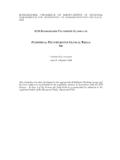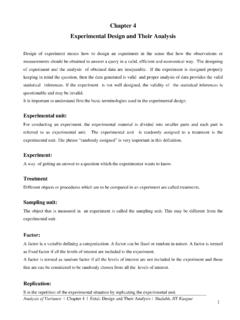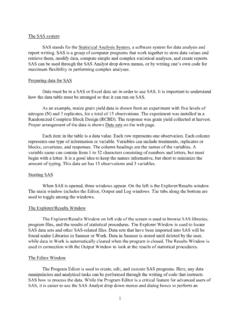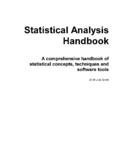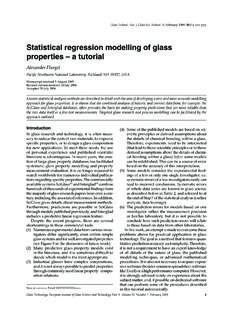Transcription of Statistical Reasoning - Georgia Standards
1 Georgia Department of Education Statistical Reasoning K-12 Mathematics Introduction The Georgia Mathematics Curriculum focuses on actively engaging the students in the development of mathematical understanding by using manipulatives and a variety of representations, working independently and cooperatively to solve problems, estimating and computing efficiently, and conducting investigations and recording findings. There is a shift towards applying mathematical concepts and skills in the context of authentic problems and for the student to understand concepts rather than merely follow a sequence of procedures. In mathematics classrooms, students will learn to think critically in a mathematical way with an understanding that there are many different ways to a solution and sometimes more than one right answer in applied mathematics. Mathematics is the economy of information.
2 The central idea of all mathematics is to discover how knowing some things well, via Reasoning , permit students to know much else without having to commit the information to memory as a separate fact. It is the reasoned, logical connections that make mathematics manageable. The implementation of the Georgia Standards of Excellence in Mathematics places a greater emphasis on sense making, problem solving, Reasoning , representation, connections, and communication. Statistical Reasoning Statistical Reasoning is a fourth mathematics course option for students who have completed Algebra II, Advanced Algebra, Accelerated Geometry B/Algebra II, or Accelerated Analytic Geometry B/Advanced Algebra. The course provides experiences in statistics beyond the CCGPS sequence of courses, offering students opportunities to strengthen their understanding of the Statistical method of inquiry and Statistical simulations.
3 Students will formulate Statistical questions to be answered using data, will design and implement a plan to collect the appropriate data, will select appropriate graphical and numerical methods for data analysis, and will interpret their results to make connections with the initial question. The Standards for Mathematical Practice through a Statistical Lens will provide the foundation for instruction and assessment. Topics should be introduced and assessed using simulations and appropriate supporting technology. Mathematics | Standards for Mathematical Practice Through a Statistical Lens Mathematical Practices are listed with each grade's mathematical content Standards to reflect the need to connect the mathematical practices to mathematical content in instruction. The Standards for Mathematical Practice through a Statistical Lens describe varieties of expertise that mathematics educators at all levels should seek to develop in their students.
4 These practices rest on important processes and proficiencies with longstanding importance in mathematics education. The first of these are the NCTM process Standards of problem solving, Reasoning and proof, communication, representation, and connections. The second are the strands of mathematical proficiency specified in the National Research Council's report Adding It Up: adaptive Reasoning , strategic competence, conceptual understanding (comprehension of mathematical concepts, operations and relations), procedural fluency (skill in carrying out procedures flexibly, accurately, efficiently and appropriately), and productive disposition (habitual inclination to see mathematics as sensible, useful, and worthwhile, coupled with a belief in diligence and one's own efficacy). Georgia Department of Education January 2, 2017 Page 1 of 7. Georgia Department of Education Statistical Reasoning 1.
5 Make sense of problems and persevere in solving them. Statistically proficient students start by explaining to themselves the meaning of a problem and looking for entry points to its solution. They analyze givens, constraints, relationships, and goals. They make conjectures about the form and meaning of the solution and plan a solution pathway rather than simply jumping into a solution attempt. They consider analogous problems, and try special cases and simpler forms of the original problem in order to gain insight into its solution. They monitor and evaluate their progress and change course if necessary. Older students might, depending on the context of the problem, transform algebraic expressions or change the viewing window on their graphing calculator to get the information they need. Statistically proficient students can explain correspondences between equations, verbal descriptions, tables, and graphs or draw diagrams of important features and relationships, graph data, and search for regularity or trends.
6 Younger students might rely on using concrete objects or pictures to help conceptualize and solve a problem. Statistically proficient students check their answers to problems using a different method, and they continually ask themselves, Does this make sense? They can understand the approaches of others to solving complex problems and identify correspondences between different approaches. 2. Reason abstractly and quantitatively. Statistically proficient students make sense of quantities and their relationships in problem situations. They bring two complementary abilities to bear on problems involving quantitative relationships: the ability to decontextualize to abstract a given situation and represent it symbolically and manipulate the representing symbols as if they have a life of their own, without necessarily attending to their referents and the ability to contextualize, to pause as needed during the manipulation process in order to probe into the referents for the symbols involved.
7 Quantitative Reasoning entails habits of creating a coherent representation of the problem at hand; considering the units involved; attending to the meaning of quantities, not just how to compute them; and knowing and flexibly using different properties of operations and objects. 3. Construct viable arguments and critique the Reasoning of others. Statistically proficient students understand and use stated assumptions, definitions, and previously established results in constructing arguments. They make conjectures and build a logical progression of statements to explore the truth of their conjectures. They are able to analyze situations by breaking them into cases, and can recognize and use counterexamples. They justify their conclusions, communicate them to others, and respond to the arguments of others. They reason inductively about data, making plausible arguments that take into account the context from which the data arose.
8 Statistically proficient students are also able to compare the effectiveness of two plausible arguments, distinguish correct logic or Reasoning from that which is flawed, and if there is a flaw in an argument explain what it is. Elementary students can construct arguments using concrete referents such as objects, drawings, diagrams, and actions. Such arguments can make sense and be correct, even though they are not generalized or made formal until later grades. Later, students learn to determine domains to which an argument applies. Students at all grades can listen or read the arguments of others, decide whether they make sense, and ask useful questions to clarify or improve the arguments. 4. Model with mathematics. Statistically proficient students can apply the mathematics they know to solve problems arising in everyday life, society, and the workplace.
9 In early grades, this might be as simple as writing an addition equation to describe a situation. In middle grades, a student might apply proportional Reasoning to plan a school event or analyze a Georgia Department of Education January 2, 2017 Page 2 of 7. Georgia Department of Education Statistical Reasoning problem in the community. By high school, a student might use geometry to solve a design problem or use a function to describe how one quantity of interest depends on another. Statistically proficient students who can apply what they know are comfortable making assumptions and approximations to simplify a complicated situation, realizing that these may need revision later. They are able to identify important quantities in a practical situation and map their relationships using such tools as diagrams, two-way tables, graphs, flowcharts and formulas.
10 They can analyze those relationships statistically to draw conclusions. They routinely interpret their Statistical results in the context of the situation and reflect on whether the results make sense, possibly improving the model if it has not served its purpose. 5. Use appropriate tools strategically. Statistically proficient students consider the available tools when solving a Statistical problem. These tools might include pencil and paper, concrete models, a ruler, a protractor, a calculator, a spreadsheet, a computer algebra system, a Statistical package, or dynamic geometry software. Proficient students are sufficiently familiar with tools appropriate for their grade or course to make sound decisions about when each of these tools might be helpful, recognizing both the insight to be gained and their limitations. For example, statistically proficient high school students analyze graphs of functions and solutions generated using a graphing calculator.











